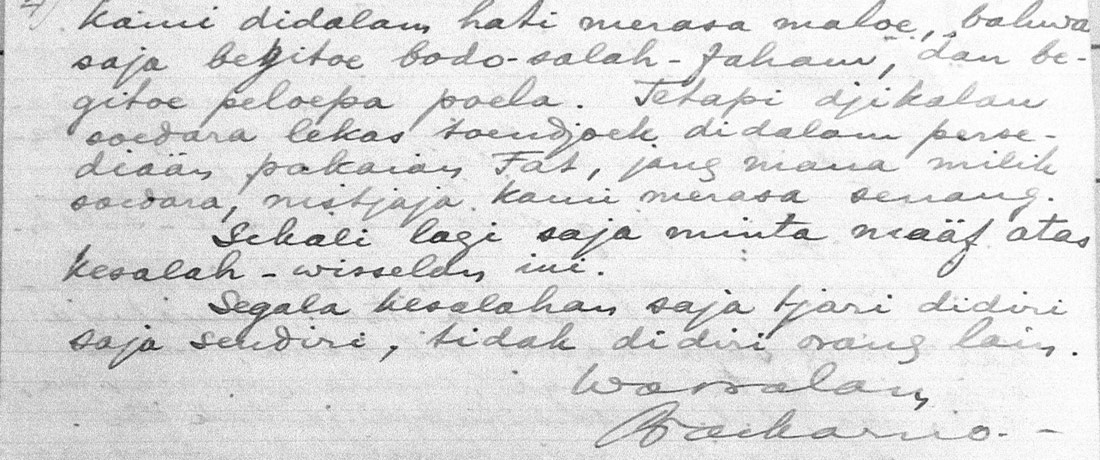
19 Oct Domestic worries of Soekarno and Fatmawati (blog by Harry Poeze)
Since 2012 KITLV has been engaged in the project ‘Dutch military operations in Indonesia 1945-1950’. At first it was to be a project of three institutions; NIOD (War Documentation Institute, Amsterdam), NIMH (Institute of Military History, part of the Ministry of Defence) and KITLV. When the request for a relatively modest subsidy was turned down by the Dutch government, participation of NIOD and NIMH was, at least temporarily, halted. KITLV went on alone, with a low public profile, but notwithstanding these drawbacks much has been achieved.
An impressive amount of documentation has been collected and analyzed with the aim of appraising Dutch military action in Indonesia, particularly where it transgressed the laws of war. We have covered the involvement of many different actors, including military men of all ranks, civil officials, politicians from cabinet and parliament, and public opinion from both the Netherlands and the Netherlands Indies. We’ve also been studying the “other side” – those from the Republik Indonesia – with special attention to the conduct of the Republik’s armed forces. Our sources have included letters, diaries, memoirs, newspaper reports as well as fictional accounts, from 1945 till the present day. The harvest so far has been abundant!
After much preparation, last month the project started work on the Nationaal Archief in The Hague. When the Dutch government’s subsidy was rejected, during discussions in the Second Chamber, the Minister of Foreign Affairs promised that he was ready to support the research project in any non-financial ways possible. Referring to this promise, we asked the Ministry of Foreign Affairs to make archives public that were hitherto closed or only accessible with restrictions. Such procedures were indeed set in motion between Foreign Affairs and the Nationaal Archief, with great success. Moreover the Nationaal Archief promised its cooperation, which resulted in a separate reading room in its building for the KITLV project and the flexible application of the rules to ensure a steady flow of documents to the KITLV researchers.
With three to five men and women, we have embarked on the ambitious project – certainly a labour of many months – to check all relevant archival material. I volunteered to go through the NEFIS files which contain more than 4,000 inventory numbers with confiscated material from the Indonesian defense. It has long been a tightly closed archive, and when open there was no description available. When at last these were added at our request, it became clear that the descriptions were generally incomplete and contained many errors.
I have now gone through about 500 files and, as I suspected/hoped, there is a lot of previously unknown material that certainly sheds new light on developments during the Japanese occupation and the Indonesian Revolution, adding an Indonesian perspective to Dutch reports of military encounters. One of these surprising finds was inventory number 3271, described as “Documents found during a house search of R.H. Osman, Petodjo 28, Batavia”.
Included was a correspondence between Osman, a tradesman, and Soekarno. In one of the few handwritten documents from Soekarno to have survived Occupation and Revolution, there was a four-page handwritten letter from 24 May 1944. In it, Soekarno provides a lengthy answer to a letter from Osman (not included in the archive) on the return of a set of textile fabrics. According to Osman, these were delivered to Soekarno’s address, partly as a marriage gift to Fatmawati, and partly to be stored. Soekarno and Fatmawati had married almost a year earlier in June 1943.
In his letter, Soekarno refers to his busy life: “I have a head full of thoughts that are connected with my obligations”, explaining that neither he nor Fatmawati could remember the details of the fabrics and apologizing for the oversight. Soekarno then invites Osman to come to his house to select the fabrics that were now part of the collection of marriage gifts. Again, politely referencing his “stupid misunderstanding”, Soekarno concludes his letter.
Reclaiming his possessions from Fatmawati’s collection was, of course, not a very attractive option for Osman. He went on to answer Soekarno with another letter, asking once more that Soekarno make the selection based on whatever he still remembers. In a postcard dated 26 June, Soekarno again professes that he really does not know which fabrics are Osman’s, and invites him to come to his house to select them. A month later, Osman replies that he cannot reclaim fabrics that were given by Soekarno to his wife. He leaves the decision with Soekarno, but cannot help noting that he procured the fabrics for 350 guilders. A bold request made from a textile trader to the future head of the Indonesian state, we can only speculate about whether he ever received any compensation from Soekarno!




No Comments